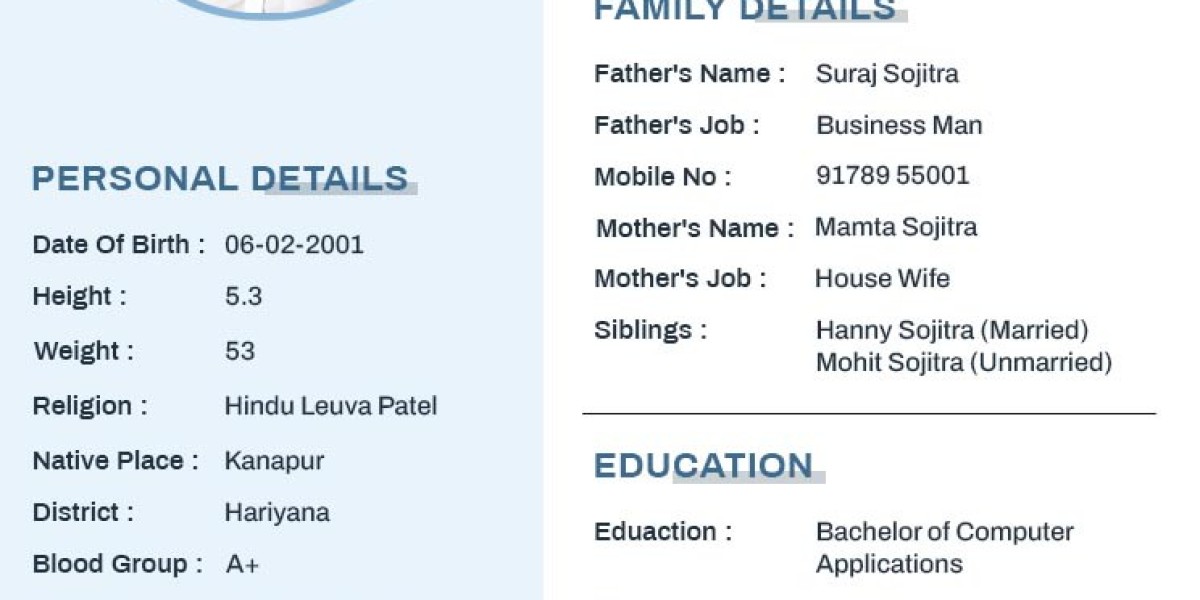In many cultures, especially in South Asia, the biodata for marriage is a traditional tool used to introduce potential life partners to each other. It serves as an essential first step in the matchmaking process, combining personal, professional, and family details into a concise, structured format. This document is similar to a resume but tailored specifically for matrimonial purposes.
A well-prepared biodata can significantly impact how you present yourself to potential partners and their families. In this guide, we will explore how to create the perfect biodata for marriage, ensuring that you highlight your strengths, values, and background in a way that is respectful, honest, and appealing.
What is a Biodata for Marriage?
A biodata for marriage is a formal document that presents a summary of your personal, familial, educational, and professional background. Unlike a job resume, which focuses on your career achievements, a marriage biodata emphasizes compatibility factors such as family background, values, personal interests, and religious beliefs.
Traditionally, biodata for marriage was a simple one-page document, but with the rise of digital matchmaking platforms, it has evolved into a more detailed profile, including photographs and personal preferences.
Why is Biodata Important for Marriage?
The biodata for marriage plays a crucial role in arranged marriages and even modern matchmaking processes. It allows potential matches and their families to assess compatibility quickly and efficiently. By showcasing essential details such as family background, values, and lifestyle, a biodata helps narrow down the search for a suitable partner, saving time and effort.
For those involved in arranged marriages, the biodata is often shared by families or intermediaries as the first step in the introduction process.
Key Elements of a Marriage Biodata
To create a complete and compelling biodata for marriage, certain essential details should be included. Let’s explore the sections that make up a traditional biodata:
1. Personal Information
The personal information section is the first part of any marriage biodata and typically includes:
- Full Name: Your first and last name.
- Date of Birth/Age: It’s essential to provide accurate information regarding your birthdate and age.
- Height and Weight: Commonly requested in biodata to give an idea of physical appearance.
- Religion and Caste: These factors are significant in many communities and should be clearly stated.
- Languages Spoken: Mention all the languages you are fluent in, as this helps assess compatibility.
- Location: Include your current city and country of residence.
2. Family Background
In many cultures, family plays a crucial role in the marriage process. This section should outline:
- Parents’ Names and Occupations: Information about your parents' professions helps provide a sense of family background.
- Siblings: Mention details about your siblings, including their education, occupation, and marital status.
- Family Values: Describe whether your family follows traditional, modern, or blended values.
This section provides a clear picture of your family’s social and economic status, which can be a deciding factor for many families.
3. Educational Qualifications
Education is an important aspect for many when evaluating potential partners. Clearly list:
- Degrees: Mention your highest qualifications.
- Institutions: State the names of universities or colleges you attended.
- Special Achievements: If relevant, include any honors or recognitions you have received.
4. Professional Background
Your professional background gives insight into your career and financial stability. Include the following:
- Current Occupation: Describe your current job title and the industry you work in.
- Employer Details: Name the company you work for and your work location.
- Income: In some biodata formats, you may choose to include your salary bracket or income range.
This section helps potential partners assess lifestyle compatibility based on career and financial factors.
5. Hobbies and Interests
The hobbies and interests section allows you to showcase your personality beyond the basics. Include:
- Favorite Activities: Mention hobbies like reading, traveling, cooking, sports, etc.
- Special Skills: Highlight unique talents or skills that reflect your personality.
This section can help potential matches relate to your lifestyle and interests.
6. Expectations for a Partner
Many biodata formats include a section where you can outline your preferences for a life partner. Some things you may want to include are:
- Age Range: Specify the age range you are looking for.
- Education: Mention if you have preferences regarding your partner’s education level.
- Location: Indicate if you are open to relocating or if you prefer someone from a particular geographic area.
- Family Values: State whether you seek a partner with traditional, modern, or mixed family values.
- Religion and Caste: If important, mention whether you have specific preferences for these aspects.
This section helps potential matches determine if their goals align with yours.
Click Here : invitation of satyanarayan pooja
Formatting Tips for Marriage Biodata
To make your biodata for marriage professional and easy to read, follow these formatting tips:
1. Keep it Concise
While it’s essential to include all necessary information, keep the biodata concise and avoid overloading it with excessive details. A one to two-page format is usually ideal.
2. Use Clear Headings
Break your biodata into sections with clear headings like Personal Information, Family Background, and Educational Qualifications. This will make the document easier to navigate.
3. Professional Layout
A clean, professional layout is crucial. Use consistent fonts, and leave enough white space between sections to make the document visually appealing.
4. Add a Recent Photograph
Most marriage biodata formats include a space for a recent photograph. Choose a clear, professional photo where you are dressed appropriately.
5. Proofread
Spelling mistakes and grammatical errors can make a bad impression. Ensure you proofread the entire biodata to make sure it is error-free and professional.
Modern Trends in Marriage Biodata
With the rise of online matrimonial sites and digital platforms, the biodata for marriage has evolved. Here are some modern trends:
1. Digital Biodata
Many people now prefer to create digital biodata that can be shared via email or uploaded on matrimonial websites. These digital formats can be more dynamic, including clickable links to social media profiles or professional websites.
2. Infographic Biodata
Some individuals opt for infographic-style biodata, which makes use of graphics and icons to present information in a visually appealing way. This modern approach can make your biodata stand out in a competitive matchmaking process.
3. Video Introductions
On some platforms, candidates can include short video introductions where they talk about themselves and their preferences. This provides a personal touch and allows potential partners to get a more comprehensive sense of your personality.
The Role of Honesty in a Marriage Biodata
One of the most important factors when creating a biodata for marriage is honesty. Misrepresenting facts about your age, family, or professional background can lead to problems later on. A biodata should be a genuine reflection of who you are, what your family is like, and what you seek in a partner. This ensures that you find a match that aligns with your values and expectations.
Conclusion
A well-crafted biodata for marriage is more than just a formality—it’s a vital tool that helps you put your best foot forward in the process of finding a life partner. By including key details about yourself, your family, and your values, and presenting the information clearly and professionally, you can increase your chances of attracting compatible matches.
Whether you choose a traditional printed format or a modern digital version, the most important thing is that your biodata reflects who you truly are and what you are looking for in a partner. With careful planning and honest representation, your marriage biodata can help you take a significant step towards finding your ideal match.







